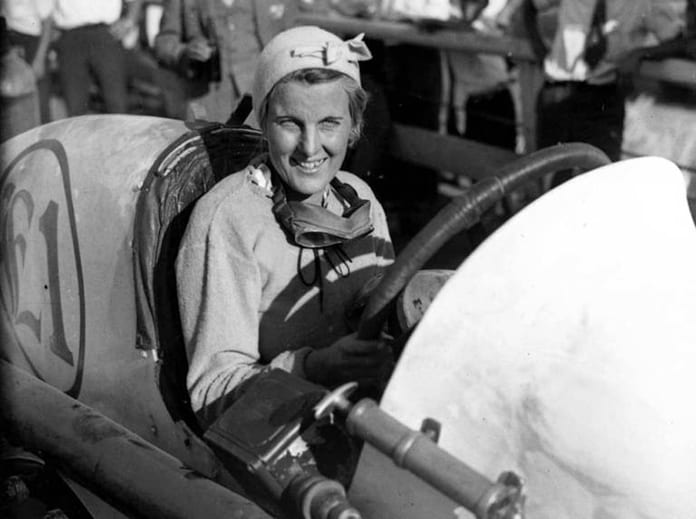This story originally appeared in the August 2016 edition of SPEED SPORT Magazine.
Because of her gender, female racer Elfrieda Mias was never able to fully pursue the sport with which she fell in love. She was born Elfrieda Hellman to a well-to-do family in Indianapolis on June 19, 1892.
As a youngster, her interest turned to more adventuresome endeavors than those usually available to Edwardian era females. Aviation first caught her dare-devilish attention and by 1910 Elfrieda was already a stunt aerialist. She hung from airplanes on a trapeze, dropped out of biplanes into speeding automobiles and was an expert wing-walker.
She soon grew disenchanted with those venturesome exploits, however, explaining that so many other women were becoming “stuntists” that it caused the profession to seem tame. In 1912, she began driving race cars.
The vocational change was also influenced by the fact she’d married race car driver Johnnie Mias in 1911. While Johnnie Mias was a so-so driver, he did compete in the 1915 Indianapolis 500. He was better known for his mechanical ability and fabrication skills. He’d constructed his own car for Indianapolis and established a steady business building and maintaining cars for others.
As Elfrieda’s racing activities advanced, one promotional tactic was to describe her spectacular car as custom built for her at a cost of $10,000. That, however, was just the typical hyperbole of that era. The car was built by Johnnie Mias and certainly not at a cost of $10,000.
Elfrieda’s personal life proved to be as adventuresome as her professional life. She divorced Johnnie Mias in 1923 and married three more times. Still, she always appeared under the name — Miss Elfrieda Mias.
The issue Elfrieda encountered when she turned to racing in the early 1900s — and fought throughout her career — was that racing sanctioning bodies did not allow women to compete against men.
She was able to obtain a competition license with the IMCA, but even though the IMCA promoted her heavily, her racing was confined to setting speed records, exhibition races against men and a few competitive efforts against other women drivers.
It’s a shame her racing activities were so restricted because she proved to be talented and fast. Her records were often quicker than those of her male counterparts on the same Midwestern, half-mile fairgrounds dirt tracks.
It was not uncommon for her to defeat men in the popular match races. In one such much-publicized effort, she won against renowned Indianapolis 500 starter Louis Disbrow.
The media loved these kinds of stories and she became one of the more publicized female sports figures of her time. The press tagged her with a number of overblown titles. At various times she was proclaimed, “The World’s Fastest Woman,” “The Speed Queen of The Universe” and the “Champion Woman Race Driver of The World.”
These grandiose titles did little, however, to further what Elfrieda really wanted — to be a serious race car driver. As the availability of track records to establish waned and the number of those willing to face her in match races diminished, she was forced to add stunt-driving exhibitions to her repertoire.
Her specialty was slamming through a board wall set ablaze with dynamite. Doing this in an open-cockpit car with only a football helmet for protection was extremely dangerous. She was seriously injured in Jackson, Miss., in 1928 and again in 1933 in Tampa, Fla. Yet, she continued with these dangerous stunts because there were few outlets for her audacious, competitive spirit.
Unfortunately, on Sept. 27, 1934, at the Alabama State Fair, things went terribly wrong. She blasted through the blazing board wall as usual, but her car unexpectedly went out control. It slammed into a road grader parked nearby, ricocheted into a ditch and through a fence surrounding the fairgrounds.
During its wild ride, the caroming car struck three people, two of them young boys. None were injured seriously, but Elfrieda died in the crash.
Her husband at that time, Ray LaPlante, watched as the stunt and ensuing crash unfolded. He believed that a flaming board landed in the car’s cockpit, burned his wife and caused her to lose control. A pioneer of women in motorsports was gone.
Her body was returned to Indianapolis where she was buried in Crown Hill Cemetery, the most concentrated resting place of racers of any cemetery in the country.
In death Elfrieda found the equality that she longed for in life.
